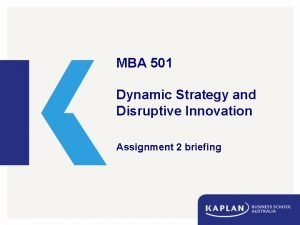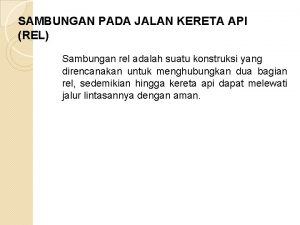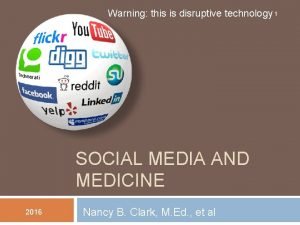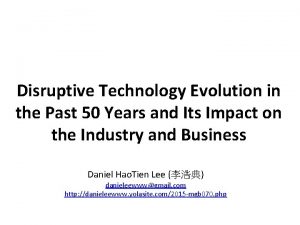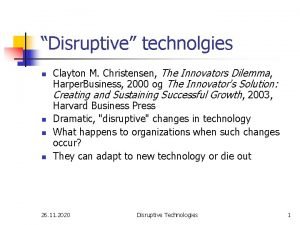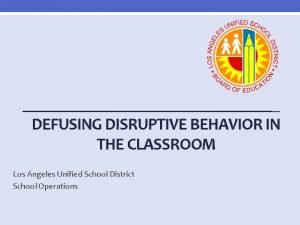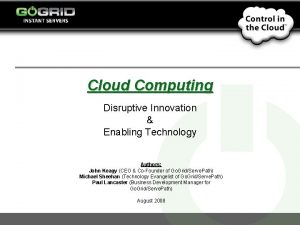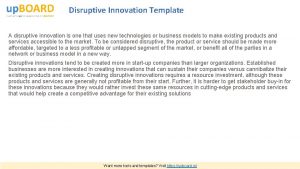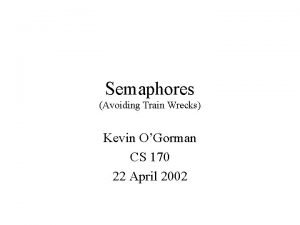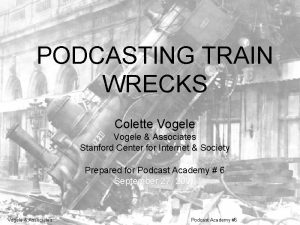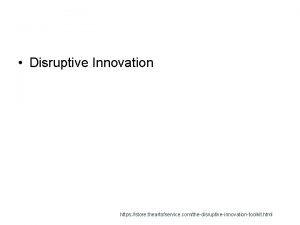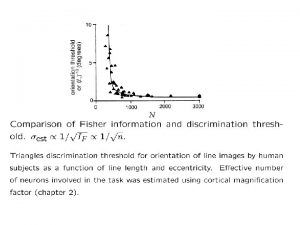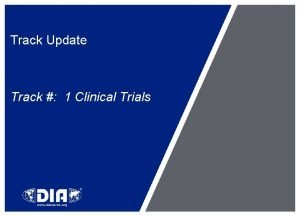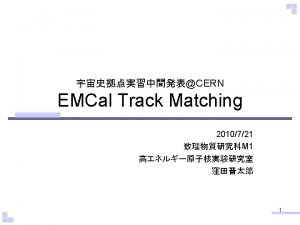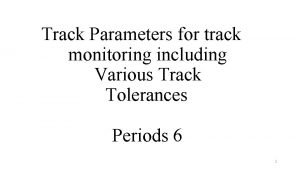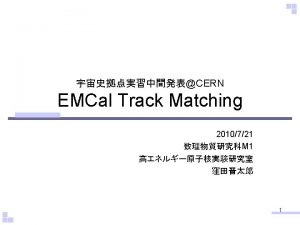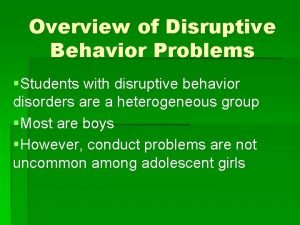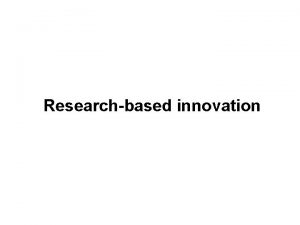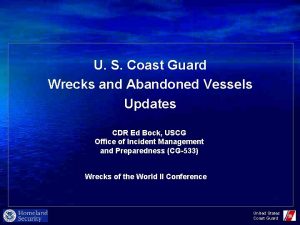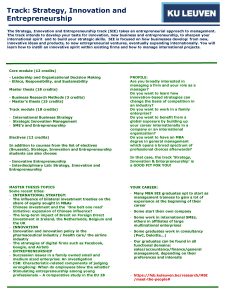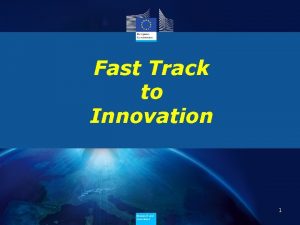Disruptive Innovation Train Wrecks on the Right Track










![“We can't get close to what Google and Amazon [and Microsoft] can do in “We can't get close to what Google and Amazon [and Microsoft] can do in](https://slidetodoc.com/presentation_image_h2/63d3363a9446143e9a6e068d782f7054/image-11.jpg)




![We Don’t Do Large Well “… a staggering 31. 1% of [IT] projects will We Don’t Do Large Well “… a staggering 31. 1% of [IT] projects will](https://slidetodoc.com/presentation_image_h2/63d3363a9446143e9a6e068d782f7054/image-16.jpg)




















- Slides: 36

Disruptive Innovation: Train Wrecks on the Right Track Edward G. Happ IFRC, Global CIO Sept 22, 2015 1

A Brief Introduction Ø 3 careers: Wall Street, management consulting, NGOs Ø Current Global CIO at IFRC Ø Co-founder and former Chairman of Net. Hope. org Ø More on Linked. In, Google and www. eghapp. com Helping to Make Connections For Good 2

Take-aways Disruptions are surprises § We are anchored to the past § The world is shifting § Our roles depend on agility § Apply lessons from DR to IT § 3

Are We Resilient?

“Even if you are on the right track, you’ll get run over if you just sit there. ” --Will Rogers, American Humorist, 1879 -1935

Strategic Context

IT Strategy Context Increasing for Beneficiaries Increasing Impact for Beneficiaries 3. Move up 2. Get in Competitive or Leading BENEFICIARY “Differentiating” Beneficiary & Field Facing PROGRAM “Improving Program Delivery” Efficient OPERATIONAL “Helping the Organization Run” FOUNDATIONAL “Keeping the Lights On” 1. Get out Donor & HQ Facing

Increasing Impact for Beneficiaries NGO/NS CIO Budgets Beneficiary & Field Facing Competitive or Leading Donor & HQ Facing Efficient BENEFICIARY “Differentiating” PROGRAM “Improving Program Delivery” OPERATIONAL “Helping the Organization Run” FOUNDATIONAL “Keeping the Lights On” April 2012 survey of international non-profit organizations (n=23) 33% 67%

What does the future NGO Data Center look like?

![We cant get close to what Google and Amazon and Microsoft can do in “We can't get close to what Google and Amazon [and Microsoft] can do in](https://slidetodoc.com/presentation_image_h2/63d3363a9446143e9a6e068d782f7054/image-11.jpg)
“We can't get close to what Google and Amazon [and Microsoft] can do in their data centers” –Peter Cochrane Why are we in the data center business? 11

Cloud providers are Tier 3 data centers Tier Level 1 Requirements IFRC is • Single non-redundant distribution path serving the IT equipment here • Non-redundant capacity components • Basic site infrastructure with expected availability of 99. 671% (28. 8 hours outage in one year) 2 • Meets or exceeds all Tier 1 requirements • Redundant site infrastructure capacity components with expected availability of 99. 741% 3 • Meets or exceeds all Tier 2 requirements Providers • Multiple independent distribution paths serving the IT equipment • All IT equipment must be dual-powered and fully compatible with the topology of a site'sare here architecture • Concurrently maintainable site infrastructure with expected availability of 99. 982% (94. 6 minutes outage in one year) 4 • Meets or exceeds all Tier 3 requirements improve • All cooling equipment is independently dual-powered, including chillers and heating, ventilating and air-conditioning (HVAC) systems -ment • Fault-tolerant site infrastructure with electrical power storage and distribution facilities with expected availability of 99. 995% (26. 3 minutes outage in one year) Cloud A 18 x From Wikipedia article on data centers 12

Disaster Recovery Challenge Questions For the Sept-2014 ETC Strategy Meeting, In five years: 1. Will the DR of Comm's in telcos and tech co's Comm's capability? surpass our DR of surpass Will cloud-sourced assessments our assessment capability (in quality, speed and reach? ) 3. Will community to community, and corporations to community program 2. delivery surpass our program delivery means? Will we see BYO-DR among responders surpass the DR we supply? The operative 5. What will we do better than others in 2020 and how will that be different word here than what we have done better? Will our leading expertise shift? is 4. “surpass” 13

Agility is a Necessity… In times of stress, organisms vary like mad, with pilots, prototypes, and trials. 14

How agile are we to technology and business change? Our Agility Index is 0. 22 number of project phases lasting less than 3 months 15
![We Dont Do Large Well a staggering 31 1 of IT projects will We Don’t Do Large Well “… a staggering 31. 1% of [IT] projects will](https://slidetodoc.com/presentation_image_h2/63d3363a9446143e9a6e068d782f7054/image-16.jpg)
We Don’t Do Large Well “… a staggering 31. 1% of [IT] projects will be cancelled before they ever get completed. Further results indicate 52. 7% of projects will cost 189% of their original estimates. ” --Standish Chaos Report, 2014. And this has not improved in the 30+ years of their tracking software projects

Disruptive Change

Three Types of Innovation* § Empowering (or disruptive) innovation – “transmutes complicated and costly products available to a few into simpler, cheaper products accessible to many” “creating new markets and wreaking havoc within industries” (e. g. , Ford Model T car) § Sustaining innovation – “replaces old models with new products that often incorporate new technology and novel design features. ” “making things incrementally bigger, more powerful, and more efficient” (ex. Toyota Prius) The false § Efficiency innovation – “makes existing products more comfort of proficiently” (ex. Lean production) incrementalism Only disruptive innovations create new jobs *Clay Christensen, Davos interview, January 2013

Disruptive Change International Civil Society Centre, Berlin, October 2013 The topic of disruptive change has gone mainstream; no ICSO leader doubted its relevance, threat and opportunity. http: //icscentre. org/area/riding-the-wave 19

Scale + speed + surprise = disruption “…over the last 20 years change itself has changed: it has become faster, more fundamental and more surprising. When these three elements come together, we experience disruption. ” --Riding the Wave, October 2013

Industries RIP 21

Potential NGO Technology Wrecks? Data centers ERPs Radio Email Cables Large projects Laptops ? 22

Overheard at the ETC Strategy Meeting “At some point someone needs to pull a cable. ” What if there are no cables? 23

The Nature of the Network is Changing The “ways in which communities use technology is based on fundamentally different ways of organising and managing a response. Community based models tend not to be top down or command-control, but to be a networked response, a digital expression of the neighbour -to-neighbour model of providing help. ” –Imogen Wall Uberfication, Airbnb Shelter, Humanitarian Trip. Advisor? 24

Some Lessons

What we can learn from disaster relief about management of IT organizations? Urgent: There is a burning platform and we are jumping (Opposite of change initiative) 2. Fast: people need attention immediately 3. Lean: red tape is something to be cut 4. Attentive: listen and amplify the voice of those on the ground 5. Flat: Management requests are overhead; diminishing returns on process 6. Good enough is good enough 7. Costs are last: Don't worry about the costs, worry about the speed 8. Preparing is not executing: Planning is preparedness, not execution 9. Improvising: Apollo 13: make do, get in done, opportunity to shine, all hands on deck 10. Humanitarian: care, trust, and humility 1. 26

What we can learn from disaster relief about management of IT organizations? 1. Urgent: There is a burning platform and we are jumping (Opposite of a change initiative) 2. Fast: people need attention immediately Lean: red tape is something to be cut 4. Attentive: listen and amplify the voice of those on the ground 5. Flat: Management requests are overhead; diminishing returns on process 3. 6. Good enough is good enough Costs are last: Don't worry about the costs, worry about the speed 8. Preparing is not executing: Planning is preparedness, not execution 9. Improvising: Apollo 13: make do, get in done, opportunity to shine, all hands on deck 7. 10. Humanitarian: care, trust, and humility 27

Fast… 28

Good Enough… Banda Aceh, 2004 Following the Tsunami response, a marketing director recalled, “We didn’t have time to have all the meetings, all the reviews, and all the approvals. ” “We had to make on-the-spot-decisions. ” “The interesting thing”, she continued, ” is that nothing fell apart. ” “Maybe we could make decisions like that everyday. ” “The Good Enough Principle “ June 2008

Humanitarian… Ø We care § People are vulnerable § People are hurting Ø The customer is the first responder § 90% of first responders are local people § Resilience is not a gift… it’s preparation and adaptability

Will we be able to move fast enough? Read the “Relevant IT Manifesto” http: //eghapp. blogspot. ch/2011/07/relevant-it-manifesto. html

Questions? §

FOR FURTHER INFORMATION ON THE DIGITAL DIVIDE INITIATIVE , PLEASE CONTACT: IFRC INFORMATION SERVICES DEPARTMENT ED HAPP, HEAD OF ISD & GLOBAL CIO TEL. : +41 022 730 4365 EMAIL: edward. happ@ifrc. org THIS PRESENTATION IS PUBLISHED BY INTERNATIONAL FEDERATION OF RED CROSS AND RED CRESCENT SOCIETIES P. O. BOX 372 CH-1211 GENEVA 19 SWITZERLAND TEL. : +41 22 730 42 22 FAX. : +41 22 733 03 95

Poster seen At Facebook Feature phones account for 43% of Facebook usage in India. Ø Only 17% access via smartphone Ø Feature phone usage is 2. 2 x the world’s mobile phone average Ø

The Movie Clip “And you, sir, are a steely-eyed missile man” Three clip, starting here: https: //www. youtube. com/watch? v=C 2 YZn. TL 596 Q 35

Synopsis § § § As humanitarians, disruptions seem to lurk around every corner. Yet the digital world has brought us expected disruptions. How do we stay resilient and turn these disruptions into success? Join us for a virtual presentation by Ed Happ, IFRC’s Global Chief Information Officer, at 10 a. m. on Tuesday, September 22 nd. Based on his experiences working on Wall Street, as a management consultant and with NGOs, Ed will share insights on how organizations can adopt and leverage disruptive changes. The late American humorist, Will Rogers, once quipped that “Even if you are on the right track, you’ll get run over if you just sit there. ” And yet large parts of our Civil Society Organizations (CSOs) infrastructure is based on last century models. A recent study by the International Civil Society concluded that “The role CSOs will play in tomorrow’s world may very much depend on their ability to anticipate and effectively navigate disruptions. ” Disruptive change is about scale, speed and surprise; the point being that it is hard to plan for, but imperative to be flexible and agile for. Will we be able to move fast enough to avoid the train-wreck? We hope you will join us for this thought-provoking discussion and consider how to positively leverage the disruptions in your work. 36
 Incremental innovation vs disruptive innovation
Incremental innovation vs disruptive innovation Right product right place right time right price
Right product right place right time right price Right time right place right quantity right quality
Right time right place right quantity right quality The path of progress is strewn with the wrecks of nations
The path of progress is strewn with the wrecks of nations Strategy assignment mba
Strategy assignment mba Sambungan rel kereta api
Sambungan rel kereta api A toy train engine rests motionless on a track
A toy train engine rests motionless on a track The right man on the right place at the right time
The right man on the right place at the right time Mysite socccd
Mysite socccd Shift disruptive learning
Shift disruptive learning Disruptive selection
Disruptive selection Theory of corona formation
Theory of corona formation Disruptive selection
Disruptive selection Dmdd diagnosis
Dmdd diagnosis Modifier placement
Modifier placement Social media disruptive technology
Social media disruptive technology Stabilizing selection
Stabilizing selection Mood dysregulation disorder
Mood dysregulation disorder Disruptive selection
Disruptive selection Disruptive technology in the past
Disruptive technology in the past Disruptive behavior disorder nos
Disruptive behavior disorder nos Disruptive selection
Disruptive selection New disruptive technologies
New disruptive technologies Defusing disruptive behavior in the classroom
Defusing disruptive behavior in the classroom Disruptive selection
Disruptive selection What is stablizing selection
What is stablizing selection Homozygosty
Homozygosty Disruptive critical voltage formula
Disruptive critical voltage formula Cloud computing disruptive technology
Cloud computing disruptive technology Disruptive agricultural technology
Disruptive agricultural technology Disruptive behavior in meetings
Disruptive behavior in meetings Disruptive
Disruptive Disruptive justice
Disruptive justice Disruptive selection
Disruptive selection New disruptive technologies 2021
New disruptive technologies 2021 Disruptive coloration
Disruptive coloration You put your left foot in
You put your left foot in




